

Internet. U.S.
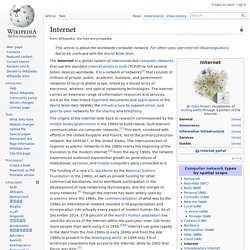
Army soldiers "surfing the Internet" at Forward Operating Base Yusifiyah, Iraq The Internet is a global system of interconnected computer networks that use the standard Internet protocol suite (TCP/IP) to link several billion devices worldwide. World Wide Web. The World Wide Web (abbreviated as WWW or W3,[3] commonly known as the web) is a system of interlinked hypertext documents accessed via the Internet.

With a web browser, one can view web pages that may contain text, images, videos, and other multimedia and navigate between them via hyperlinks. History[edit] In the May 1970 issue of Popular Science magazine, Arthur C. Clarke predicted that satellites would someday "bring the accumulated knowledge of the world to your fingertips" using a console that would combine the functionality of the photocopier, telephone, television and a small computer, allowing data transfer and video conferencing around the globe.[10] On March 12, 1989, Tim Berners-Lee wrote a proposal that referenced ENQUIRE, a database and software project he had built in 1980, and described a more elaborate information management system.[11]
HTML. HTML or HyperText Markup Language is the standard markup language used to create web pages.
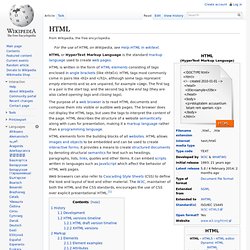
HTML is written in the form of HTML elements consisting of tags enclosed in angle brackets (like <html>). HTML tags most commonly come in pairs like <h1>and </h1>, although some tags represent empty elements and so are unpaired, for example <img>. The first tag in a pair is the start tag, and the second tag is the end tag (they are also called opening tags and closing tags). The purpose of a web browser is to read HTML documents and compose them into visible or audible web pages.
XML. Extensible Markup Language (XML) is a markup language that defines a set of rules for encoding documents in a format which is both human-readable and machine-readable.
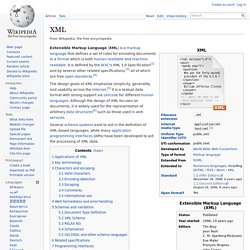
It is defined by the W3C's XML 1.0 Specification[2] and by several other related specifications,[3] all of which are free open standards.[4] The design goals of XML emphasize simplicity, generality and usability across the Internet.[5] It is a textual data format with strong support via Unicode for different human languages. Although the design of XML focuses on documents, it is widely used for the representation of arbitrary data structures[6] such as those used in web services.
Several schema systems exist to aid in the definition of XML-based languages, while many application programming interfaces (APIs) have been developed to aid the processing of XML data. Application programming interface - Wikipedia, the free encyclop. In computer programming, an application programming interface (API) specifies how some software components should interact with each other.
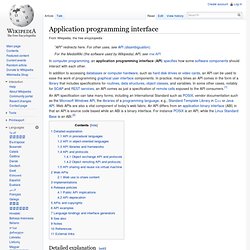
Detailed explanation[edit] API in procedural languages[edit] In most procedural languages, an API specifies a set of functions or routines that accomplish a specific task or are allowed to interact with a specific software component. This specification is presented in a human readable format in paper books, or in electronic formats like ebooks or as man pages. For example, the math API on Unix systems is a specification on how to use the mathematical functions included in the math library. Programming language. The earliest programming languages preceded the invention of the digital computer and were used to direct the behavior of machines such as Jacquard looms and player pianos.[1] Thousands of different programming languages have been created, mainly in the computer field, and many more still are being created every year.
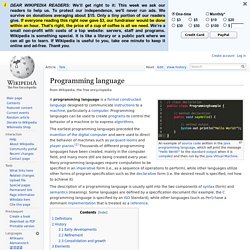
Many programming languages require computation to be specified in an imperative form (i.e., as a sequence of operations to perform), while other languages utilize other forms of program specification such as the declarative form (i.e. the desired result is specified, not how to achieve it). Java (programming language)
Duke, the Java mascot Sun Microsystems released the first public implementation as Java 1.0 in 1995.[1] It promised "Write Once, Run Anywhere" (WORA), providing no-cost run-times on popular platforms.

Fairly secure and featuring configurable security, it allowed network- and file-access restrictions. Major web browsers soon incorporated the ability to run Java applets within web pages, and Java quickly became popular. With the advent of Java 2 (released initially as J2SE 1.2 in December 1998 – 1999), new versions had multiple configurations built for different types of platforms. For example, J2EE targeted enterprise applications and the greatly stripped-down version J2ME for mobile applications (Mobile Java).
JavaScript. JavaScript is classified as a prototype-based scripting language with dynamic typing and first-class functions.
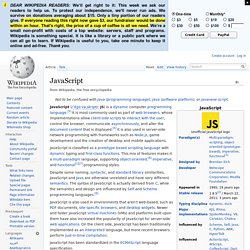
This mix of features makes it a multi-paradigm language, supporting object-oriented,[6] imperative, and functional[1][7] programming styles. JavaScript has been standardized in the ECMAScript language specification. Adobe Flash. Flash manipulates vector and raster graphics to provide animation of text, drawings, and still images.
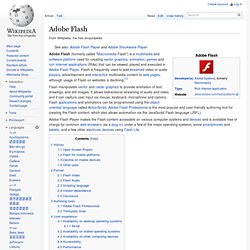
It allows bidirectional streaming of audio and video, and it can capture user input via mouse, keyboard, microphone and camera. Flash applications and animations can be programmed using the object-oriented language called ActionScript. Adobe Flash Professional is the most popular and user-friendly authoring tool for creating the Flash content, which also allows automation via the JavaScript Flash language (JSFL). History[edit] Object-oriented programming. Overview[edit] Rather than structure programs as code and data, an object-oriented system integrates the two using the concept of an "object".
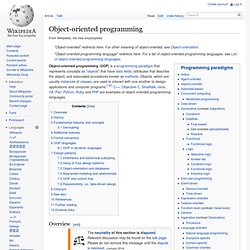
An object has state (data) and behavior (code). Objects correspond to things found in the real world. So for example, a graphics program will have objects such as circle, square, menu. An online shopping system will have objects such as shopping cart, customer, product.